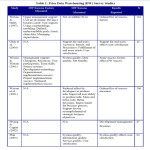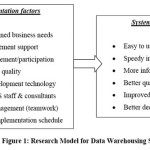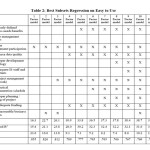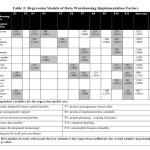Dr. Shobha.D
Associate Professor,DOS In Computer Science Pooja bhagavat memorial mahajana PG centre,K.R.S Road,Metagalli,Mysore,India
Article Publishing History
Article Received on :
Article Accepted on :
Article Published : 26 Jul 2014
Article Metrics
ABSTRACT:
Organization are increasingly tuning to data warehouses for decision making.why is it that certain projects fail, while others succed? The aim of this article is to identify the key success factors for data warehouse implimentation, few studies have assessed data warehousing practices in general and critical success factors for implimentation . some have proved guidelines for implimentation but no framework exists which are used to find the success factors. This article provide key success factors for data warehouse implimentation and how best to utilize their limited resource to choose critical succes factors.
KEYWORDS:
Data warehouse; Critical Succes factors; system success; Information Technology
Copy the following to cite this article:
Shobha D. Key Success Factors for Data Warehouse Implimentation:Analysis. Orient. J. Comp. Sci. and Technol;7(2)
|
Copy the following to cite this URL:
Shobha D. Key Success Factors for Data Warehouse Implimentation:Analysis. Orient. J. Comp. Sci. and Technol;7(2). Available from: http://www.computerscijournal.org/?p=1060
|
INTRODUCTION
Data Warehouse (DWH) is a technique for properly storing and managing data from different data sources for the purpose of business performance analysis. Decision support system (DSS) is an area of the information systems (IS) discipline that focuses on supporting and improving managerial decision making. In terms of contemporary professional practice, DSS includes personal decision support systems (PDSS), group support systems (GSS), executive information systems (EIS), online analytical processing systems (OLAP), data warehousing (DW), and business intelligence (BI). Data warehouse system represent a single source of information to analyze the devolopment and results of an organization. It is an important area of practice and research, few studies have been conducted to assess data warehousing practices in general and cretical success factors for implimentation in particular (Watson et al.2001; wiscom and watson 2001).Some case studies identifies that some factors contributing to the success or failure of data warehousing implimentation. Each study identifies specific factors and understands implimentation factors and their effect on data warehous success, the purpose of this paper is to identify the key success factors for dataware house implimentation.
PROBLEM BACK GROUND
While corporations are increasingly tuning to data warehouses for support of critical corporate decesion making, but it remains unknown about the succes of data warehouse. Unfortunately ,the precise nature of the success factors and their impact on data ware housing are still unclear(Mukherjee and D’souza,2003). In order to fill this gap, the current study identifies a number of implimentation factors and tests their effect on success.
METHODOLOGY
The literature is of practitioner’s accounts of data warehousing projects that have succeded. A few case studies have invenstegated data warehouse implimentation at claims and fendings in a cross section survay. In the end some academic journals were selected for furthe analysis.
PRIOR DATA WAREHOUSING SURVAY STUDIES:
When different factors are analysed in different studies, it is very difficult to compare research findins to pin down the exact implimentation factor and their impact on data warehousing success as shown in the table1.
KEY FACTORS THAT AFFECT DATA WAREHOUSE SUCEESS
Failure of a data warehouseing project are categories as design , technical, procedural and socio-technical factor. Wixom and watson (2006) investigated the effects of several implimentation factors on three success variable. The fig shows the success variables by consolidating lists from prior data warehousing studies. Model for data warehousing success
System Success
The first two variables “easy to use” and “speedy information retrieval” measure the quality of the system developed. some attractive features that apply to other systems, such as scalability, standardization, and security have been mentioned (Sakaguchi & Frolick) a data warehouse that is not user-friendly in either its user interface or the analysis tools provided can result in millions of dollars of unused software and unrealized returns on investment (Gorla, 2003; Johnson, 2004). The next two variables “more information” and “better quality information” measure the benefits reflected in the output of a system–information. Both the quality and quantity of information are important. Researchers generally agree that proper use of a data warehouse can make its users more efficient and effective. The final two variables “improved business processes” and “increased competitive position” measure benefits accrued at the organizational level, the factors that contribute to the success or failure of data warehouses.
I selected eleven factors based on these prior lists and a review of other data warehousing studies. The first three factors “clearly defined business needs/benefits,” “top management support,” and “user involvement/participation” measure the operational aspect of the project. User involvement/participation is important to IS projects in general (Hwang & Thorn, 1999) and data warehousing in particular (Conner, 2003; Watson & Haley, 1997; Wixom & Watson, 2001). The next four factors “source data quality,” “proper development technology,” “adequate IS staff and consultants,” and “project management/teamwork” measures the availability of technical resources and expertise for the project. Almost all authors emphasize the technical aspects of data warehousing projects, including cleansed data, Meta data, standard methodology, and project management as very critical to the success of the project (e.g., Baker & Baker, 1999; Joshi & Curtis, 1999; Sammon & Finnegan, 2000; Vatanasombut & Gray, 1999; Watson & Haley, 1997; Wixom & Watson, 2001). Almost all authors emphasize the technical aspects of data warehousing projects, including cleansed data, meta data, standard methodology, and project management as very critical to the success of the project (e.g., Baker & Baker, 1999; Joshi & Curtis, 1999; Sammon & Finnegan, 2000; Vatanasombut & Gray, 1999; Watson & Haley, 1997; Wixom & Watson, 2001). The next two factors “practical implementation schedule” and “proper planning/scoping of project” measure how reasonable the time allowed for development of a data warehouse is. Proper planning and execution of the implementation schedule is critical to data warehousing success (Baker & Baker, 1999; Sigal, 1998; Watson, Fuller, & Ariyachandra, 2004). Moreover, “scope creep” has been cited as a common cause of data warehousing project failure (Conner, 2003).
Based on the research model discussed above, a questionnaire was developed to collect data on the eight data warehousing success variables and eleven implementation factors as perceived by data warehousing professionals. Surveys are a common approach for collecting the large amounts of data needed for statistical testing of relationships.
Table 2 shows the eleven best subsets regression results on the first success variable, “easy to use.” For each possible number of variables to be used as predictors, Minitab calculates the four criteria mentioned above and displays the best model. The model with six variables was considered the best because its Cp is close to and less than P. A separate regression was then run using those six selected variables as predictors. The coefficients for the intercept and the factors, along with the R2 value are displayed in Table 3. Similar procedures were followed to select variables and obtain regression results for other success variables.
As shown in Table 3, all but one factor, “top management support,” is included in some best subsets models. At the same time, each success variable is a function of different implementation factors. All the factors in the best subsets models are considered critical except the ones with a negative coefficient. All the critical factors are shaded in Table 3 for easy identification. In addition, the regression coefficients represent the magnitude of the impact of each factor. While some coefficients are very close, others differ greatly. It is not surprising that they have a positive effect on the two system quality variables: “easy to use” and “speedy information retrieval.” “More information” is a function of two critical success factors: “project management” and “adequate funding.” “Project management,” along with “source data quality,” is critical to the production of “better quality information.” Both “source data quality” and “project management” are related to the technical aspect of a project.
A variety of factors are responsible for a data warehouse’s individual benefits. To achieve “improved productivity,” “user involvement/participation,” “adequate IS staff and consultants,” “adequate funding,” and “measurable business benefits” are critical. The benefit of “better decisions,” however, is dependent on “clearly defined business needs/benefits,” “adequate IS staff and consultants,” “project management,” and “measurable business benefits.” Only two factors are critical to “improved business processes”: “adequate funding” and “measurable business benefits.” Finally, a data warehouse may enhance a company’s competitive position if three factors are in place: “clearly defined business needs/benefits,” “project management,” and “measurable business benefits.” Since not much research has been done to investigate the determinants of a data warehouse’s individual or organizational benefits, interpretation of our initial evidence warrants caution. Nevertheless, the factor that is the most common among all regression models and thus may be the most important is “measurable business benefits.” This makes sense since in order to produce tangible benefits such as “improved productivity” or “better business process,” the deliverables must be defined beforehand.
CONCLUSION
Success variables individual factors are important and the strength of their effects on different success variables need to identify. These studies differed in the methodology used and most studies were on personal experiences. Operational and technical areas need more attention, organization must learn how to identify the critical issues that affect the implementation process and know the process to address them effectively to ensure that the promised benefits can be realize and potential failures can be avoided ,so proper use of a data warehouse can make its users more efficient and effective.
REFERENCE
- Ader, & Mellenbergh, G. 2011. Advising on Research Methods: A consultant’s companion. 3rd ed. Huizen, The Netherlands: Johannes van Kessel Publishing.
- Ariyachandra, T., & Watson, H. 2006. Which Data Warehouse Architecture Is Most Successful? Business Intelligence Journal, 11 (1).
- Baker, S. & Baker, K. The best little warehouse in business. Journal of Business Strategy, 20:2, Mar/Apr 1999, pp.32-37.
- Beal, B. 2005. Report: Half of data warehouse projects to fail. Retrieved May 22, 2011, from Search CRM:
- Inman, W. H.: Building the Data Warehouse. Wiley & Sons (1996).
- Literature. Journal of Data Warehousing, 2:1, January 1997, 34-54.
- Sigal, M. A common sense of development strategy. Communications of the ACM, 41:9, September 1998, pp.42-43.
- P. Bingi, M. K. Sharma, and J. K. Godla, “Critical Issues Affecting an ERP Implementation”, Information Systems Management, 16, 3, 1999, pp. 7-14.
- Wixom, B., & Watson, H. 2001. An Empirical Investigation of the Factors Affecting Data Warehousing Success. MIS Quarterly , 25 (1), 17-41.
CrossRef
- Wixom, B.H. & Watson, H.J. An empirical investigation of the factors affecting data warehousing success. MIS Quarterly, 25:1, March 2001, pp. 17-4.

This work is licensed under a Creative Commons Attribution 4.0 International License.




